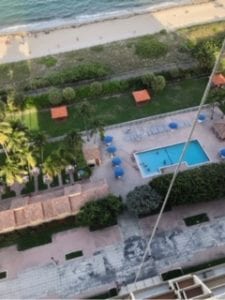
Here in Miami, we think of ourselves as “ground zero” in the battle with sea level rise.
Think again. Rotterdam is ground “minus-zero.” Sitting mostly below sea level, this extraordinarily resilient city has turned to nature, rather than just building concrete walls, for its elaborate, enormous buffers.
Rotterdam uses enhanced sand dunes to resist not just the incessantly increasing sea, but also the inevitable surge of the otherwise calm ocean when atmospheric disturbances roil the temper of the god Neptune and cause the rumbling, salty sea to crash into their shores.
More than the actual sea level, which over the last century has creeped up very slowly, at a mere 3 millimeters per year (equivalent to one foot per 100 years), Miami needs to deal with two other, less predictable but more voluminous phenomena.
Let me take them in ascending order of importance.

KING TIDES
For a more visual and technical explanation, the reader should look up (www.mbrisingabove.com); you will see there a pithy, but technically coherent explanation of how moon cycles (as well as the sun) affect, by their gravitational pull, the tides, such that a couple of times a year, the tidal surge of ocean water creates a substantial increase in sea level.
In the last couple of years, this phenomenon has quieted down; it turns out that the moon is moving away for half of a 19-year cycle. So, for the next 8.5 years, we are pretty safe. (Last year’s King Tides were reported by Herald writer Alex Harris as a mere “trickle.”)

STORM SURGES
Here we find the achilles heel of Miami’s ocean water containment. Depending on the force and location of a hurricane’s impact, our shores could be submitted to a momentary rise in sea level that can reach as much as 15 feet. That’s not exactly a Tsunami, but it is enough to flood Collins and Brickell (mostly at 3 feet above sea level), as well as South Bayshore, which has a bluff on its Western side but lies low on the East.
The result of a Hurrican Andrew, with its eight-foot surge, is devastating not only because of the force of the water propelled but because of the greater force of buoyancy, which easily lifts boats and even bridges, if they are not well anchored.
WHY DUNES ARE BETTER THAN SEAWALLS
Dunes are better than seawalls for every reason imaginable. In Miami Beach, we sort of backed into this solution to storm surges; our intention was to protect sea turtles, which used the dunes for their nests. A couple of decades ago, the State of Florida began a program of beach renourishment that pushed up the dunes, as the sand meets the boardwalk, a couple of feet. Wild grasses and other vegetation began to accumulate to the point that at the level of the Fountainbleau Hotel (43rd Street), the sand-cum-vegetation now rises a good four to five feet!
The beach renourishment, coupled with the now thickly overgrown grassy dunes, provides a hefty buffer to storm surges. By my calculations, it will require a 6-8 foot storm surge before we see any significant flooding in Collins, all the way north of Ocean Drive and at least past the Fountainebleau Hotel. (My estimate was validated a couple of years ago, during Irma, when the only serious flooding that took place in the mentioned stretch was from the overflow of Indian Creek Canal, where the recently-built retainining wall ended.)
One other reason why natural barriers (such as dunes) are more desirable than seawalls is that, up to now, the seawalls are typically made of steel-reinforced concrete, which rusts away and contaminates the very oceanfront we are trying to protect. Luckily for us, here in Miami there is a company that produces basalt-based reinforcement bars and a university (UM), whose science department is testing the new, resilient technology.
Miami and its coastal cities are at the forefront of resiliency. We’re truly “rising above” our former status as “ground zero.”
Miami-Dade County Commissioner Xavier L. Suarez can be reached at 305-669-4003 or via email at district7@miamidade.gov.







Comments are closed.